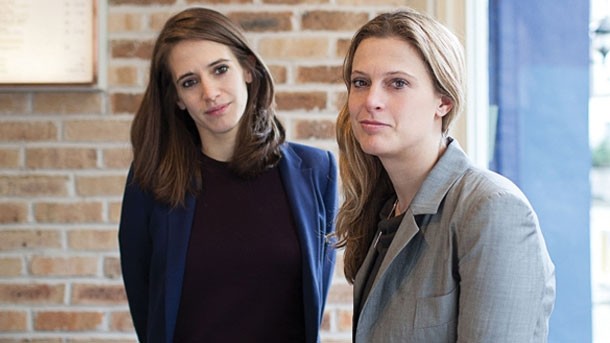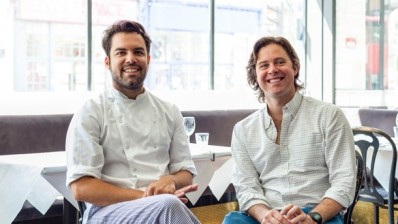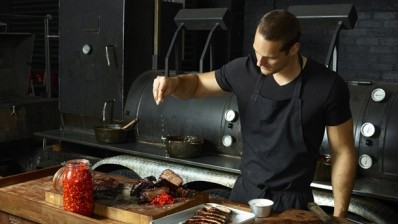SMALL TALK
Ana and Sanja Morris on Le Coq and rotisserie chicken restaurants

Le Coq is all about chicken, right?
Ana: It’s a rotisserie restaurant. We change our menu on a weekly basis but we always have three starters followed by free-range chicken and sides and then a choice of desserts. People like not having a choice. They know they are coming in for chicken and then gain faith that everything else we do is good. We do mix it up on Sundays, where we serve diferent rotisserie items alongside chicken, such as pork ribs, octopus and salmon. It’s fun to experiment.
Why a rotisserie restaurant?
Ana: There was nobody in London doing true rotisserie. Clockjack [in Soho] has rotisserie chicken but it’s on a vertical spit. When you cook chicken horizontally it bastes itself but doing it that way all the juice falls out. That said, from our research it is nice chicken. Chicken Shop is not a true rotisserie restaurant either as they steam the chickens first and then brown them, whereas we cook our chickens on the rotisserie from beginning to end.
That must come with challenges…
Ana: Waste is a problem. We have a holding draw, which means we can keep them for about two hours, but no longer really. The chicken benefits from sitting in the draw for at least half an hour as it gives it a chance to rest.
Sanja: Size is another challenge. We ideally want 1.8kg chickens but we can get birds up to 2.2kg. We have to pay more for them but can’t charge our customers more. We also have to tell the farm growing the chickens from eggs what we think we’ll need in 14 weeks time (two weeks gestation and 12 weeks growing time).
Where do you source your chicken?
Sanja: From Sutton Hoo farm, in Sufolk.
Ana: They are truly free range chickens as they are reared for 12 weeks. The majority of free range chickens are only reared for eight weeks.
Sanja: This gives them a slightly richer taste than your average chicken. The chicken is also denser as they have more exercise.
Ana: The dark meat is slightly darker, too. Everyone gets a piece of white and dark meat.
How did you come to work together?
Sanja: It was never an intention to do so. It just happened organically.
Ana: I’m a chef and Sanja is more on the business side. The reason I became a chef was because I started working with Sanja at Salt Yard in 2005 [Sanja co-founded London restaurants Salt Yard, Dehesa and Opera Tavern]. I left there after six months and went to La Trompette and then to New York where I was head chef for a catering company.
Sanja: When Ana was living in New York I went to visit her. We went out for dinner and started talking about chicken. We reached the idea at the same time that it would be so nice to go somewhere that does really good chicken. This was before all the chicken restaurants opened. I was in the middle of stepping back from Salt Yard and thinking about another project.
And does the sibling relationship work on a business level?
Ana: Yes. We’ve always agreed on what a good restaurant is and should be like. We have different skills. I’m more on the food side and Sanja has business knowledge. It’s been a good partnership where we lean on each other.
Sanja: Ana very much operates it, while I’m more hands off. I now live in Edinburgh. Initially I came down once a week and now it’s once a fortnight, but we’re on the phone constantly.
Why did you choose Islington?
Ana: We originally looked at Soho, which is where most of Salt Yard Group’s restaurants are, but soon realised rents were extortionate there. More importantly we decided we wanted a neighbourhood restaurant and to be in that kind of environment, and Soho’s completely different from that. We went to [Italian restaurant] Trullo for lunch and talked about how great it would be to open somewhere like that, and then stepped out of the door, walked five doors down and there was this empty site for sale.
Sanja: It was a very skanky Chinese restaurant, so we completely gutted it. We’ve now got a 40-cover place plus space for 14 downstairs in our private dining room, or den as we call it.
And you’re looking for more sites?
Sanja: We are beginning to look in a relaxed fashion. The idea is to find a bigger site because it’s frustrating that we’re having to turn people away. We’d like 80 covers with a bar area in a place with more lunchtime trade, maybe north or east London. King’s Cross would be ideal but it’s probably too expensive.
Ana: And for the next one to have two rotisseries, one dedicated to chicken and one to fish.
Sanja: We’d like a few smaller restaurants too, once we have opened a bigger one.
Do you have other plans?
Ana: We will continue to do our rotisserie takeovers, which are on the last Monday of the month. We are on our seventh now and they are really popular. We hand over the restaurant to a chef or a restaurant – the last one was a novelist who had written about food – and they choose the menu. We take a break from chicken for a day. Bonnie Gull is next with a seafood feast of scallops, crab and hake. A lot of Bonnie Gull’s customers are coming and a lot of our regulars. Some people come to every single takeover.
Sanja: from the beginning of next year we want a mobile rotisserie, too. We did one wedding last year but we were asked to do a lot more in the countryside, but obviously we can’t at the moment. We’ll partner up with ice cream and wine suppliers to have a complete offer.
Ana: Our office delivery and takeaway offer is also going to grow.


























